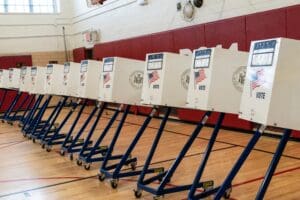
A generation later, the images of Florida election workers surrounded by mountains of ballots as they recounted votes in the 2000 presidential election are a distant memory. An entire nation was riveted by the recount, bewildered that the balance of power hung on human interpretation of “pregnant chads,” “hanging chads” and “dimpled chads.” Guessing voter intent based on a butterfly ballot was imprecise at best. There had to be a better way. A computer could solve the problem, right? Let’s dive into this week’s Tech Time Warp.
Security concerns unveiled
Well, not so fast. Twenty years ago, a Maryland state agency conducted a security test on the state’s new Diebold electronic voting machines, proving that guess-proofing the electoral process was no simple matter. On January 29, 2004, in preparation for the state’s March primary during the 2004 presidential election cycle, the Maryland Department of Legislative Services released a report detailing the findings of “the Red Team,” a group of consultants with National Security Agency experience. The Red Team sought to hack into Maryland’s voting machines any way they could. The team’s findings were concerning, though the consultants assured governmental officials the problems could be remedied. Among the issues:
- The machines’ removable memory cards could easily be tampered with as the machine’s lock could be picked or its key could be stolen. The machines all used the same physical key, per the Red Team report. (The consultants recommended the use of “tamper tape” to indicate a physical intrusion.)
- The communication lines between the machines and a central server were not secure, allowing for easy access by the nefarious.
- The machines were shipped with standard, easy-to-guess administrative passwords.
- Up-to-date security patches to address potential operating system vulnerabilities were not installed.
The consultants were “genuinely surprised at the basic level of the exploits,” according to news reports. This wasn’t Diebold’s only electronic voting controversy: The company settled with the State of California—also in 2004—over alleged false claims about the security of its equipment. And its Ohio-based CEO was a fierce supporter of President George W. Bush. You might recall that Ohio was the deciding state in the 2004 U.S. presidential election.
Did you enjoy this installation of SmarterMSP’s Tech Time Warp? Check out others here.
Photo: lev radin / Shutterstock
